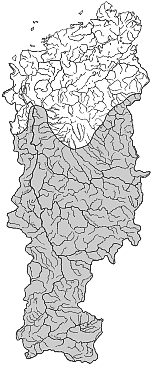|
|
| Main |
| Systematic List |
| Photo |
| Central Siberia |
| Guest book |
| Awards |
| SEARCH |
|---|
|
|
Hirundinidae |
|---|
Sand Martin Riparia riparia (Linnaeus, 1758)
|
 Sand Martins enjoy a wide distribution in Central Siberia from the southern limits of the region north to Dudinka. Absent in montane regions, the species is generally found in areas with steep slopes of clay or sand and is particularly numerous in the flat part of the Minusinsk depression. The species nests mainly in steep river banks but also in exposed anthropogenic slopes. A majority of the colonies along the Yenisey River in southern taiga (59°- 60° N), where the population density averages 31 birds/10 km of river bank, is located on the vertical left bank of the river in the vicinity of villages. In 1977, reports of larger colonies included: a colony near the village of Novonazimovo of over 100 nests, one near Fomka with 50-60 nests, one on the Bolshoy-Kosovsky Island with 40-50 nests, and the largest, a colony in the sidewall of a silo pit in Pogodaevo with 200-250 nests. Searches along the tributaries west of the Yenisey revealed small numbers on their lower reaches. For example, three colonies were found in the lower 150 km of the Kas River: one in the Kas mouth contained 25 nests, the other two hosted 5 and 11 pairs (Bursky and Vakhrushev 1983). Searches along the eastern tributaries, however, failed to turn up any breeding birds at all, except in the Chuna River basin, a secondary tributary of the Angara River, where larger populations were seen in settlements in June (27 birds/km2). In other places it was common (2 birds/km2) (Ravkin 1984). Furthermore, in 1962, rather large colonies of up to 400-500 pairs were not rare along the lower Angara River in the vicinity of Motygino (Syroechkovski et al. 1978). The Yenisey mid taiga hosts large Sand Martin populations, the largest of which occurred near the villages of Bor, Podkamennaya Tunguska, Lebed, and Bakhta and contained several hundred, even over 1000 pairs. Several dozen small colonies were found as well, one of which found near the station at Mirnoye contained 150 occupied burrows in 1970. As vegetation gradually overgrew the site, the population dwindled to 10 occupied burrows in 1983 and finally disappeared altogether in 1984. Meanwhile, however, intensive erosion of the river bank on sites 200 and 500 m distant from the original colony opened up new nesting opportunities that were colonized in 1974 and 1985, respectively. The Yenisey tributaries host only small populations in this region: several dozen pairs nest in the lower reaches of the Varlamovka and the Sarchikha Rivers where they cut deeply into the Yenisey alluvium. Along the Bakhta River, Sand Martin populations are also low; nesting is limited to the lower 120 km of the river. Searches have failed to procure the species within the Stolbovaya River basin or along its upland tributaries, nor has it been found along the adjoining Podkamennaya Tunguska River. Migration patterns of Sand Martins were traced for 8 years near Mirnoye. The first swallows appear between May 17 and June 9, and most birds have arrived by the end of the first third of June. Breeding begins immediately and is completed during the last 10 days of June. Prior to and during their southward migration, Sand Martins generally gather in compact flocks, engaging in behavior evidently aimed at strengthening their social bonds. They rest together for a long time on aerial wires or perform aerial social displays, slicing the water surface at precisely the same spot. On one occasion, on July 25-29, a flock of several hundred birds descended on a tiny sedge island of only several square meters. At some point in the course of the season, the local breeding population of 150-200 birds is joined by a second migrating flock of approximately the same size. The following day, if the young are fully fledged, all birds may disappear. The final Sand Martin aggregations of the season meet near Mimoye on August 31. In northern taiga, the Sand Martin is a common species. The average density along theYenisey River amounts to 3-4 breeding birds/km2. The same value is typical of the lower reaches of the Pakulikha River. Forty-one birds/km2 were found on steep sandy slopes in Turukhansk (65°45' N) in 1977. The two largest of four colonies found in the vicinity of Angutikha village in 1956-1958 and in 1963 were located on Bolshoye Konoshchelye Island and contained up to 200 pairs each, (Rogacheva and Vakhrushev 1983). Occasional sightings of birds near Tura in Evenkia (typical northern taiga, 64° 15' N) in the summer of 1978 suggest probable breeding nearby (Vakhrushev and Vakhrusheva 1987). Within the extreme northern taiga of the Norilsk valley, breeding Sand Martins are still common. Aside from the usual river bank burrows, Sand Martins here also construct burrows within peat hillocks along the shores of taiga lakes. Typical colonies here consist of 20-30 burrows (Krechmar 1966). Further north, in the Yenisey forest-tundra, the Sand Martin is a rare visitor but has been recorded as far north as 69° N. During the years 1956-1963, a small active colony existed on a Yenisey River island near Nikolskoye (Rogacheva et al. 1983). Small breeding colonies with 15-20 nests settle locally in forest-tundra in the upper Turukhan River valley, and breeding occurs regularly on the southern shores of the Sovietskiye Lakes at 67° N (Rogacheva et al. 1987). |
[Back] |
|
|
|
|
Сайт разработан и поддерживается кафедрой прикладной экологии и ресурсоведения СФУ
